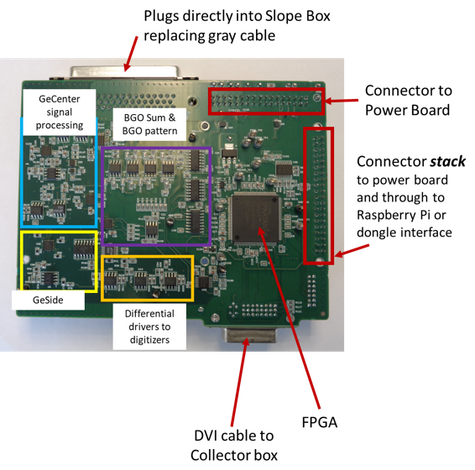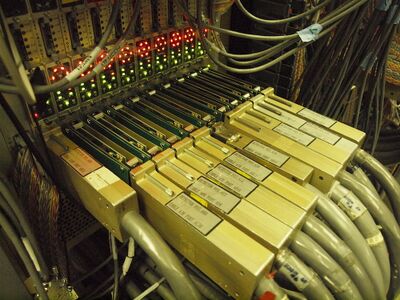The Pickoff Card
The "SBX pickoff card" attached to the SBX of each detector receives the single-ended signals for the Ge Center, Ge Sides, and BGO segments from the Slope Box. It converts these to differential signal format before sending them to the rest of the DAQ system. The SBX pickoff card is an FPGA-based design that provides a communication hub interfacing the preamp, power board, dongle and slope box to EPICS through a serial interface. Its receives all analog signals from the detector by directly plugging into the Slope Box, eliminating the "grey cables" that existed prior to the Gammasphere Upgrade. From the 10 detector signals (Ge center contact, two Ge Side contacts and 7 BGO signals) the SBX pickoff generates the four digitizer signals GeCenter, BGOsum, GeSide & BGOpattern. Many signal conditioning and multiplexing options for these four signals are included, all controllable from software through the FPGA's communication interface. New signal combination modes built into the SBX pickoff's design now also enable new measurements that were previously unavailable. These new features include
- Software programmable DC offsets for all four digitizer signals
- 16 different, software-selectable gain settings for the GeCenter signal
- 16 different, software-selectable decay time constants for the GeCenter signal
- Software programmable voltage comparator to detect preamp reset conditions, connected to software programmable clamping circuit (DC level and clamp time) for baseline restoration after preamp reset
- 5 level programmable attenuation for the BGO sum signal
- 16 different signal multiplexing/addition combinations for the GeSide channel providing access to both side channels, a 2nd copy of the GeCenter at fixed 5MeV full scale gain and many FPGA-based digital pulse signals for diganostics and system tuning
- Individual BGO discriminators with programmable threshold for every BGO scintillator, connected both to FPGA based rate counters and to the collector box via a fast serial interface for formation of the electric honeycomb 2nd-order suppression data
- Software selectable access, through the BGOpattern digitizer channel, to each BGO scintillator signal, the BGO pattern signal, or a 3rd copy of the GeCenter signal at fixed gains of either 8Mev full scale or 17MeV full scale
Figure 1 shows the SBX pickoff card, with its various subsections highlighted. Parts of the pickoff card are dedicated to the processing of specific signals, like the Ge center, Ge sides, and BGO sum and BGO pattern. It is designed to stack up with the SBX power board, and has protruding connectors on two different sides to do so. It has connectors for an optional Raspberry Pi, which is meant to enable standalone detector operation. A DVI cable attaches to the pickoff card for connection to the collector box. This DVI cable contains the four digitizer signals plus power and communications. The FPGA of the SBX pickoff performs automated scanning of the Preamp, the Power Board and the Slope Box continuously in the background using scan programs stored in read-only memory. At startup, the EEPROMs of both the Preamp and the Dongle are also read. Within the pickoff firmware, scanner machines run these scan programs with the help of transactor machines that perform individual reads/writes tailored to the specific communications protocols of each device (speed, signal types, etc). The data collected from these scanners are placed into a dual-port RAM inside the FPGA to make all collected status values available to EPICS. All scanners can be paused to allow EPICS to manually insert commands to the transactors to set any detector device to new values. The status information collected by all these scanners is then written into a dual-port RAM by an arbiter machine. Values in the dual-port RAM are read by EPICS just like any register of the pickoff FPGA, hiding all device-specific timing from EPICS.
The VXI Pickoff Card (Before the Gammasphere Upgrade)
Large many-conductor grey cables ran between the Slope Box on each detector to the Pickoff cards in the VXI crates of the old system. The VXI Pickoff Card received the single-ended signals for the Ge Center, Ge Sides, and BGO segments from the Slope Box. The VXI pickoff converted them to differential signal format before sending them to the digitizer. Detector signals were sent as single-ended signals on coax cables that were part of the grey cables, running parallel with multiple power supply voltages plus communication. All power for Gammasphere detectors was generated by the bulk power supplies of the VXI crates, that also had to power the VXI cards. The long cable runs and many connectors often resulted in noisy or marginal power for the detectors, and failing contacts in these cables caused an ever-growing maintenance issue. The VXI pickoff passed the power and slow control through from the VXI cards to the grey cable while intercepting the side and center Ge signals plus the 7 BGO signals, converting them into the same GeCenter, BGOsum and GeSide differential digitizers still in use today. The original VXI pickoff did not implement the BGOpattern signals or support for the electric honeycomb in any way. While sufficient for many experiments, the "pass-through" mechanical nature of the VXI pickoff card created mechanical contact difficulties. The functionality of the VXI pickoff has been completely replaced and significantly expanded upon by the SBX pickoff card.

